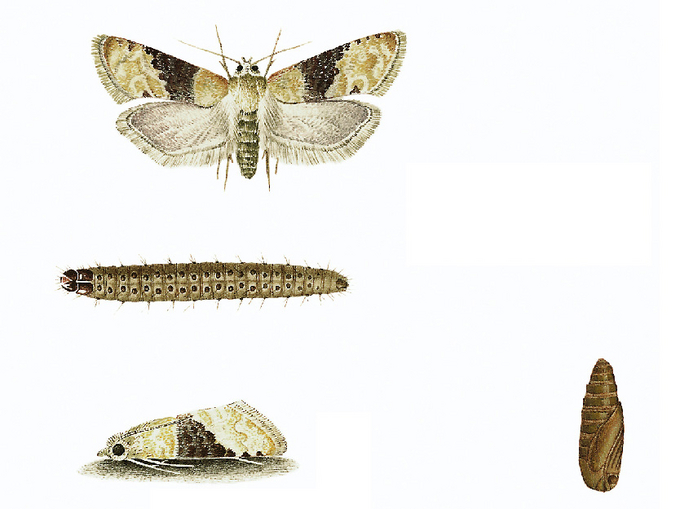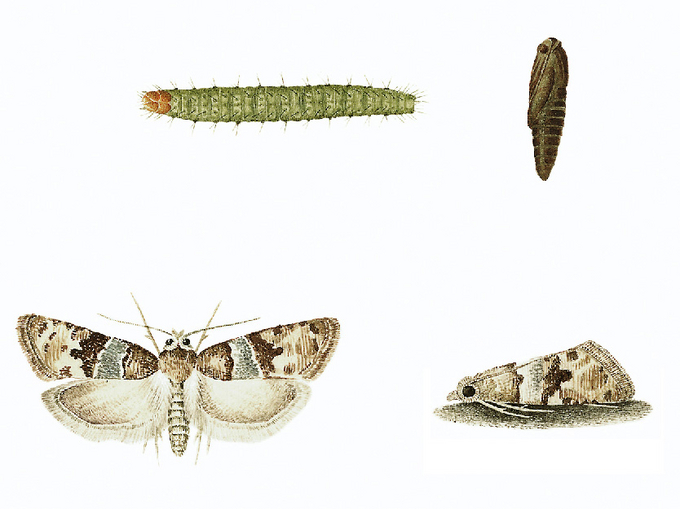Grape berry moth
Eupoecilia ambiguella and Lobesia botrana
Appearance
The moths of the one-banded grape berry moth are 6-7 mm long and have straw-yellow colored wings with a characteristic brown-black transverse band with a wingspan of 12-14mm.
The lenticular eggs are about 0.6 x 0.9 mm and shortly after oviposition are transparent with orange-yellow spots. Shortly before hatching, the black head of the caterpillar becomes visible (blackhead stage).
The caterpillars grow to 10-12 mm, are brown-reddish in color and have a black head capsule.
The pupae are light brown in color and 6-8 mm long.
The moths of the Crossed Grape Moth are about 5-6 mm long and have yellow-green colored wings with a gray marbling with a wingspan of 12-13 mm.
The eggs are similar in shape, size, and color to those of the one-banded grape berry moth, but do not have orange-yellow spots after oviposition.
The caterpillars are 8-10 mm long, green-gray to green-brown in color, and have a yellow head capsule.
The pupae are olive-brown colored and 5-6 mm long.


Biology
Both grape berry moth species usually produce two generations per year, called hayworm (first generation) and sourworm (second generation). Hibernation occurs as a pupa under the bark of the vine or other host plants and in cracks of supporting stakes of the vineyards. At temperatures above 11 °C (males) or 12.8 °C (females), the moths of the first generation hatch towards the end of April. The male moths hatch about a week before the females.
The monocotyledonous grape berry moth has a flight period of about two to five weeks per generation with a distinct flight peak.
In the case of the crossed gra pe berry moth, the flight periods of the individual generations often merge and cannot always be separated.
The eggs of the first generation of grape berry moths are laid by the females on the flower capsules of the vine blossoms. About a week after the eggs are laid, the caterpillars (hayworm) hatch and feed on the inflorescences for three to four weeks. The fifth and final caterpillar stage goes into a one to two week pupal dormancy. The flight of the second generation begins in late June.
The eggs of the second generation grape berry moth are laid individually on the berries. After a week, the caterpillars (sour worm) hatch and feed in the berries until they pupate from the end of July.
In warmer regions or in warmer years, a third generation of grape berry moths may also appear in September (sweet worm).
Damage symptoms
The caterpillars of the first generation (hayworm) feed on the inflorescences of the vine (shoots) from about the end of May to the end of June, hollow out flower buds and spin them for protection.
The caterpillars of the second generation (sour worm) eat the growing berries after boring inside (about the end of July to the beginning of August) and create entry ports for infestation with fungal pathogens such as gray mold(Botrytis cinerea) via the boring holes.
The third generation caterpillars can severely damage the ripe berries from mid-September to early October.
Host plants
While the monocotyledonous grape berry moth occurs exclusively on grapevines(Vitis), the crossed grape berry moth can infest various host plants and has so far been found on the following plant genera: Grapevine(Vitis),Clematis, Dogwood(Cornus), Honeysuckle (Lonicera), Snowball(Viburnum), Privet (Ligustrum), Gooseberry (Ribes), Ivy (Hedera),Daphne, Rosemary (Rosmarinus), and Barberry (Berberis).
Prevention and control
- Pheromones can be used against the grape berry moth as part of the confusion technique
- Possible dates for biological and chemical treatment measures can be found under Warning Service Plant Health
- Plant protection products for the control of the plum moth are listed in the register of plant protection products approved in Austria
Specialized information
Publikationen
Blümel, S., Eitzinger, J., Gruber, B., Gatterer, M., Altenburger, J., Hausdorf, H., 2020. Influence of weather variables on the first seasonal occurrence of the grape berry moths Eupoecilia ambiguella (Lepidoptera: Tortricidae) and Lobesia botrana (Lepidoptera: Tortricidae) in a case study region in Austria. Mitteilungen Klosterneuburg 70, 115-128.
Polesny, F.; Rupf, O., Kuhrer, E., 2000. Tortricid pests in orchards and viticulture, from basic data sampling to internet warning service. EPPO Bulletin 30(1), 127-129.
Last updated: 12.03.2024
automatically translated